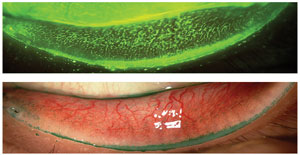 |
|
Increased age mapped onto greater severity of staining and LWE parameters, which is consistent with previous literature findings. Photo: Jalaiah Varikooty. Click image to enlarge. |
Ocular surface punctate staining is a common feature linked to several anterior segment conditions, especially dry eye. Although corneal and conjunctival staining both are recognized as diagnostic signs of the disease, they demonstrate poor discriminative performance in mild-to-moderate cases, leading researchers to look at other possibilities for diagnostic markers.
Investigators from the University of Auckland published a new study in Ocular Surface that evaluated diagnostic performance of both corneal and conjunctival staining along with lid wiper epitheliopathy (LWE) in detecting dry eye disease; this manifestation was defined by the global consensus Tear Film and Ocular Surface Society Dry Eye Workshop II (TFOS DEWS II) criteria.
Included in the study was a total of 2,066 community residents (1,285 women; mean age 40 ±19 years). The investigator-masked, prospective study had participants evaluated for dry eye symptomology and ocular surface parameters in a single clinical session; an independent masked assessor also evaluated each for corneal and conjunctival staining score and Korb LWE grading.
|
For more on lid wiper epitheliopathy, see this feature. |
A significant 39% (n=807) of participants met criteria for dry eye disease according to TFOS DEWS II parameters. Of these individuals, 9% were classified with moderate-to-severe disease. The study researchers found that discriminative abilities of superior and inferior LWE were greater than those of corneal and conjunctival staining. LWE was detected more commonly in both mild-to-moderate and moderate-to-severe dry eye, as well as displaying a more consistent correlation with other ocular parameters across a broader range of disease severity.
In the discussion section of their paper, the authors highlight that advanced age was also associated with greater severity of all ocular surface staining and LWE parameters. As well, LWE was seen in a greater proportion than corneal staining regardless of age group or severity classification of dry eye. What’s more, particularly marked in the younger age group and in those with milder severity was the prevalence of LWE and corneal staining. The authors relay that “these results are consistent with those reported by earlier diagnostic studies that demonstrate poorer discriminatory performance of corneal staining in mild-to-moderate dry eye disease and suggest that its presence might signify more severe disease.”
Also touched upon is that subgroup analysis revealed corneal and conjunctival staining were only significantly correlated with other clinical dry eye signs and symptoms in moderate-to-severe individuals, while LWE served as an informative marker in this group as well as the mild-to-moderate group.
Jennifer P. Craig, FCOptom, PhD, part of the University of Auckland’s Department of Ophthalmology and one of the authors of this paper, discusses how the group’s observations may relate to greater public health: “Our findings certainly have some clinical relevance as they confirm that LWE staining is superior to corneal staining at detecting dry eye. Corneal staining tends to be a late findings in dry eye disease, often not detected until patients are older, and/or the disease has progressed to a more severe stage.”
Dr. Craig further expounds that “in providing the best patient care, it’s important that we make a prompt diagnosis so that treatment can be commenced, as this can help alleviate patient symptoms, resolve clinical signs and ultimately might help to avoid or slow disease progression. Routine slit lamp examination of the everted eyelids after staining with lissamine green dye is a simple way to aid identification of LWE, and allow an earlier dry eye diagnosis to be made, benefitting patients.”
Wang MTM, Power B, Xue AL, Craig JP. Discriminative performance of ocular surface staining and lid wiper epitheliopathy in dry eye disease: an investigator-masked, prospective registry-based, diagnostic accuracy study. Ocul Surf. July 20, 2024. [Epub ahead of print]. |


